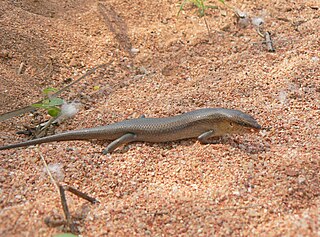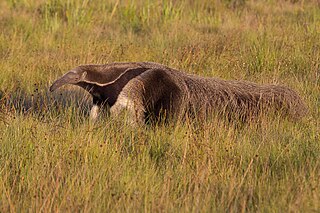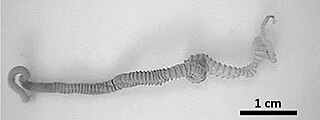Sepsina is a genus of skinks. The genus is endemic to southern Africa.

The southern tamandua, also called the collared anteater or lesser anteater, is a species of anteater from South America and the island of Trinidad in the Caribbean. It is a solitary animal found in many habitats, from mature to highly disturbed secondary forests and arid savannas. It feeds on ants, termites, and bees. Its very strong foreclaws can be used to break insect nests or to defend itself.

The Myrmecophagidae are a family of anteaters, the name being derived from the Ancient Greek words for 'ant' and 'eat'. Two genera and three species are in the family, consisting of the giant anteater, and the tamanduas. The fossil Eurotamandua from the Messel Pit in Germany may be an early anteater, but its status is currently debated.

Tamandua is a genus of anteaters in the Myrmecophagidae family with two species: the southern tamandua and the northern tamandua. They live in forests and grasslands, are semiarboreal, and possess partially prehensile tails. They mainly eat ants and termites, but they occasionally eat bees, beetles, and insect larvae. In captivity, they will eat fruits and meat. They have no teeth and depend on their powerful gizzards to break down their food.

The long-tailed pangolin, also called the African black-bellied pangolin or ipi, is a diurnal, arboreal pangolin species belonging to the family Manidae, in the order Pholidota. They feed on ants rather than termites. The common names for this species stem from physical characteristics, such as the extremely long tail or the dark hairs that cover the underside of their bodies and limbs. Pangolin comes from the Malay word pengguling, meaning “something that rolls up”.

Hakaria is a genus of skink, a lizard in the family Scincidae. The genus contains one species, Hakaria simonyi, which is endemic to Socotra.
Stumpffia tetradactyla is a species of frog in the family Microhylidae. It is endemic to Madagascar. Its natural habitats are subtropical or tropical moist lowland forests and heavily degraded former forest. It is threatened by habitat loss..

Allactaginae is a subfamily of rodents.

Gillmeria ochrodactyla is a moth of the family Pterophoridae found in Asia and Europe. It was first described by the Austrian entomologists, Michael Denis & Ignaz Schiffermüller in 1775.

Anteaters are the four extant mammal species in the suborder Vermilingua, commonly known for eating ants and termites. The individual species have other names in English and other languages. Together with sloths, they are within the order Pilosa. The name "anteater" is also commonly applied to the aardvark, numbat, echidnas, and pangolins, although they are not closely related to them.

Gigantorhynchida is an order containing a single family, Gigantorhynchidae of Acanthocephala that parasitize vertebrates by attaching themselves to the intestinal wall of their host. There are over 60 species classified into three genera in GigantorhynchidaGigantorhynchus, Intraproboscis, and Mediorhynchus.

Gillmeria is a genus of moths in the family Pterophoridae. The genus was described by the English schoolteacher and entomologist, James William Tutt in 1905.

The Itigi-Sumbu thicket is an ecoregion consisting of two small areas of thick shrubland in Tanzania, Zambia and the adjacent Democratic Republic of the Congo, in East Africa. The floral community of dense deciduous brush is unique, with many endemic species, and almost no transition zone between it and the surrounding dry miombo woodlands. The distinctive nature of this small region is partly due to its setting on dry alluvial soil over a hard duricrust, while the surrounding areas are rocky hills and plateaus.
The Angatuba Ecological Station is an ecological station in the state of São Paulo, Brazil.

Carlia tetradactyla, the southern rainbow-skink, is a small species of colourful lizard found in Australia.
Flexiseps ardouini, also known commonly as the yellow skink, is a species of lizard in the family Scincidae. The species is endemic to Madagascar.

Sepsina alberti, also known commonly as Albert's skink and Albert's burrowing skink, is a species of lizard in the family Scincidae. The species is endemic to Namibia.
Sepsina angolensis, the Angola skink, is a species of lizard which is found in Namibia, Angola, Zambia, and Democratic Republic of the Congo.
Sepsina bayonii, also known commonly as Bayon's skink, is a species of lizard in the family Scincidae. The species is native to Central Africa and Southern Africa.
Sepsina copei, also known commonly as Cope's reduced-limb skink or the sepsina skink, is a species of lizard in the family Scincidae. The species is endemic to Angola.












